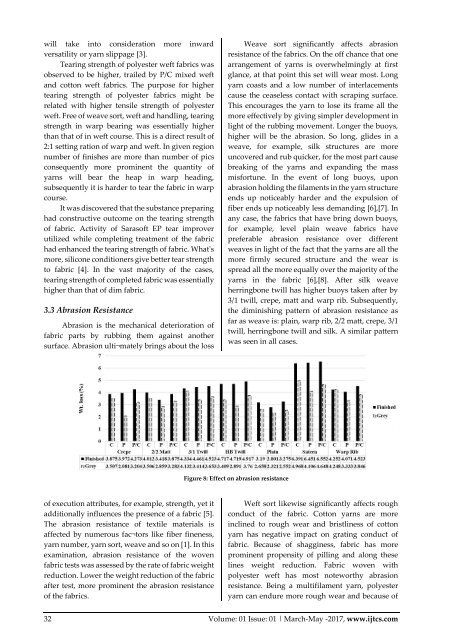IJTCS Vol.-1 Issue-1 March-May, 2017
The Indian Journal of Textile and Clothing Science (IJTCS) is a peer reviewed (refereed) national journal (India). Which is aimed at providing platform to exchange information pertaining to all sectors of textile and the clothing industry among researchers, textile technocrats, fashion designers and industrial experts. The journal focuses on scientific, technical, economical, managerial and all other aspects of textile activity at theoretical and experimental level. IJTCS is aimed at publishing original research articles, review papers, short communications, and letters to the editor and book reviews catering the needs of both industry and academia.
The Indian Journal of Textile and Clothing Science (IJTCS) is a peer reviewed (refereed) national journal (India). Which is aimed at providing platform to exchange information pertaining to all sectors of textile and the clothing industry among researchers, textile technocrats, fashion designers and industrial experts.
The journal focuses on scientific, technical, economical, managerial and all other aspects of textile activity at theoretical and experimental level. IJTCS is aimed at publishing original research articles, review papers, short communications, and letters to the editor and book reviews catering the needs of both industry and academia.
You also want an ePaper? Increase the reach of your titles
YUMPU automatically turns print PDFs into web optimized ePapers that Google loves.
will take into consideration more inward<br />
versatility or yarn slippage [3].<br />
Tearing strength of polyester weft fabrics was<br />
observed to be higher, trailed by P/C mixed weft<br />
and cotton weft fabrics. The purpose for higher<br />
tearing strength of polyester fabrics might be<br />
related with higher tensile strength of polyester<br />
weft. Free of weave sort, weft and handling, tearing<br />
strength in warp bearing was essentially higher<br />
than that of in weft course. This is a direct result of<br />
2:1 setting ration of warp and weft. In given region<br />
number of finishes are more than number of pics<br />
consequently more prominent the quantity of<br />
yarns will bear the heap in warp heading,<br />
subsequently it is harder to tear the fabric in warp<br />
course.<br />
It was discovered that the substance preparing<br />
had constructive outcome on the tearing strength<br />
of fabric. Activity of Sarasoft EP tear improver<br />
utilized while completing treatment of the fabric<br />
had enhanced the tearing strength of fabric. What's<br />
more, silicone conditioners give better tear strength<br />
to fabric [4]. In the vast majority of the cases,<br />
tearing strength of completed fabric was essentially<br />
higher than that of dim fabric.<br />
3.3 Abrasion Resistance<br />
Abrasion is the mechanical deterioration of<br />
fabric parts by rubbing them against another<br />
surface. Abrasion ulti¬mately brings about the loss<br />
Weave sort significantly affects abrasion<br />
resistance of the fabrics. On the off chance that one<br />
arrangement of yarns is overwhelmingly at first<br />
glance, at that point this set will wear most. Long<br />
yarn coasts and a low number of interlacements<br />
cause the ceaseless contact with scraping surface.<br />
This encourages the yarn to lose its frame all the<br />
more effectively by giving simpler development in<br />
light of the rubbing movement. Longer the buoys,<br />
higher will be the abrasion. So long, glides in a<br />
weave, for example, silk structures are more<br />
uncovered and rub quicker, for the most part cause<br />
breaking of the yarns and expanding the mass<br />
misfortune. In the event of long buoys, upon<br />
abrasion holding the filaments in the yarn structure<br />
ends up noticeably harder and the expulsion of<br />
fiber ends up noticeably less demanding [6],[7]. In<br />
any case, the fabrics that have bring down buoys,<br />
for example, level plain weave fabrics have<br />
preferable abrasion resistance over different<br />
weaves in light of the fact that the yarns are all the<br />
more firmly secured structure and the wear is<br />
spread all the more equally over the majority of the<br />
yarns in the fabric [6],[8]. After silk weave<br />
herringbone twill has higher buoys taken after by<br />
3/1 twill, crepe, matt and warp rib. Subsequently,<br />
the diminishing pattern of abrasion resistance as<br />
far as weave is: plain, warp rib, 2/2 matt, crepe, 3/1<br />
twill, herringbone twill and silk. A similar pattern<br />
was seen in all cases.<br />
Figure 8: Effect on abrasion resistance<br />
of execution attributes, for example, strength, yet it<br />
additionally influences the presence of a fabric [5].<br />
The abrasion resistance of textile materials is<br />
affected by numerous fac¬tors like fiber fineness,<br />
yarn number, yarn sort, weave and so on [1]. In this<br />
examination, abrasion resistance of the woven<br />
fabric tests was assessed by the rate of fabric weight<br />
reduction. Lower the weight reduction of the fabric<br />
after test, more prominent the abrasion resistance<br />
of the fabrics.<br />
Weft sort likewise significantly affects rough<br />
conduct of the fabric. Cotton yarns are more<br />
inclined to rough wear and bristliness of cotton<br />
yarn has negative impact on grating conduct of<br />
fabric. Because of shagginess, fabric has more<br />
prominent propensity of pilling and along these<br />
lines weight reduction. Fabric woven with<br />
polyester weft has most noteworthy abrasion<br />
resistance. Being a multifilament yarn, polyester<br />
yarn can endure more rough wear and because of<br />
32 <strong>Vol</strong>ume: 01 <strong>Issue</strong>: 01 | <strong>March</strong>-<strong>May</strong> -<strong>2017</strong>, www.ijtcs.com



